18 Types of Brown Caterpillars (With Pictures) – Identification Guide
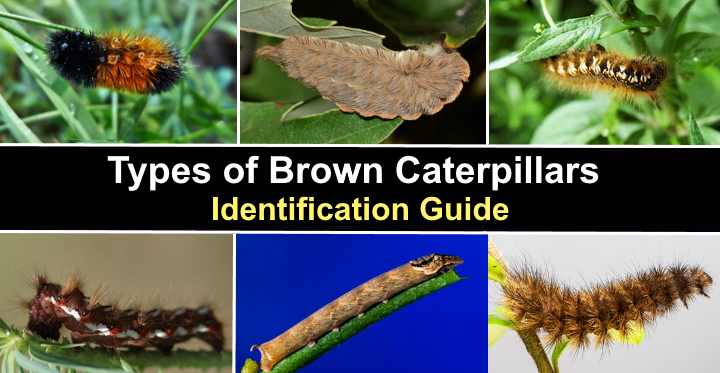
Brown caterpillars are worm-like larvae with furry, smooth, or patterned bodies. The long cylindrical insects may look brown and drab, but they transform into stunning moths or butterflies. Although most brown caterpillars are harmless, some species of brown furry caterpillars have stinging hairs or spines that can cause a nasty skin rash if you handle them.
Like all caterpillar species, brown caterpillars are a type of insect belonging to the order Lepidoptera. A caterpillar’s life cycle starts as an egg that hatches into a larva. Brown caterpillars are known for their insatiable appetite, and they feed on plant leaves, sometimes causing a great deal of damage. Brown caterpillars then pupate and go through metamorphosis into butterflies or moths.
When identifying a brown caterpillar, it’s good to remember that the insects go through several instars (growth stages). During these stages, a caterpillar’s appearance and color can change dramatically. For example, some large caterpillars are brown before pupation but are bright green in their previous instars.
This article is a comprehensive guide to common types of brown caterpillars. Descriptions and pictures of brown caterpillar features will help you identify these worm-like creatures on ornamental plants, trees, and shrubs.
Brown Caterpillar Identification
Brown caterpillars can be identified by their brown color, three pairs of true legs, and several stumpy-looking prolegs (false legs). Brown caterpillars typically have segmented bodies, and they can be furry, smooth, or have spiny protrusions. Some unusual hairless brown caterpillars have eye-like markings, giving them a strange appearance.
Looking at brown caterpillars can also help to identify stinging caterpillars. For example, the brown hag moth caterpillar is covered in stinging hairs and looks like a dried leaf. Also, the brown-tail moth caterpillar has a dark brown body with tufts of spines that cause a nasty skin rash.
Types of Brown Caterpillars With Names and Pictures (Identification Guide)
The best way to identify species of brown caterpillars is to look at pictures of the crawling insects and learn about their behavior and habitat. Here is a list of some of the types of brown caterpillars you are likely to find in the garden.
Brown-Tail Moth Caterpillar (Euproctis chrysorrhoea)
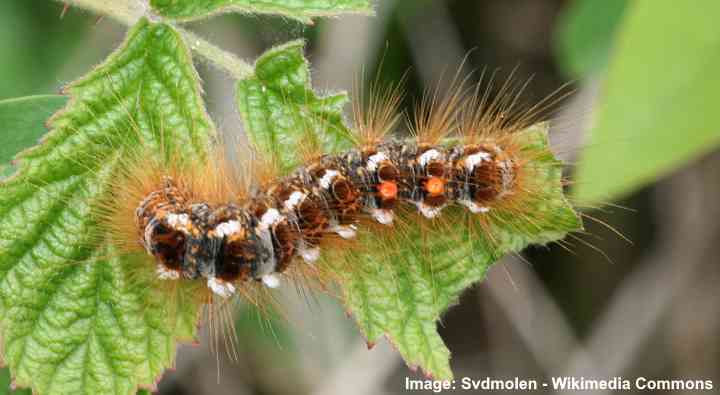
The brown-tail moth caterpillar has white marking and stinging hairs on its body
The brown-tail moth caterpillar has a slender, dark brown body and two identifiable orange-red spots on its back is covered in stinging orange or yellow hairs. The brown-tail moth caterpillar has two recognizable white stripes along its back and reddish-brown markings on the segments. Brown-tail moth caterpillars grow 1.5” (38 mm) long.
Brown-tail moth caterpillars are a type of stinging caterpillar covered in tiny poisonous hairs that can cause dermatitis similar to poison ivy, especially in sensitive individuals. People may develop dermatitis from direct contact with the caterpillar or indirectly from contact with airborne hairs.
You can find the browntail moth caterpillars on host plants such as oak trees, maple trees, birch, ash, and various types of fruit trees. The brown larvae overwinter in webs dangling at the end of branches.
Brown caterpillar identification
Brown-tail caterpillars have a dark brown body with white markings and have two prominent red spots in the middle of their backs. The slender brown insects are covered in tufts or dark yellow or orange hairs.
- Adult Stage: Brown-tail moth, a small, white moth
- Caterpillar Feeds on: Various deciduous trees and shrubs, including oak, apple, and cherry trees
- Habitat: Woodlands, gardens, urban areas; primarily found in Europe, including countries like the United Kingdom and parts of continental Europe
- Stinging: The brown-tail moth Caterpillar has stinging hairs on its body that can cause skin irritation upon contact
Woolly Bear Caterpillar (Pyrrharctia isabella)
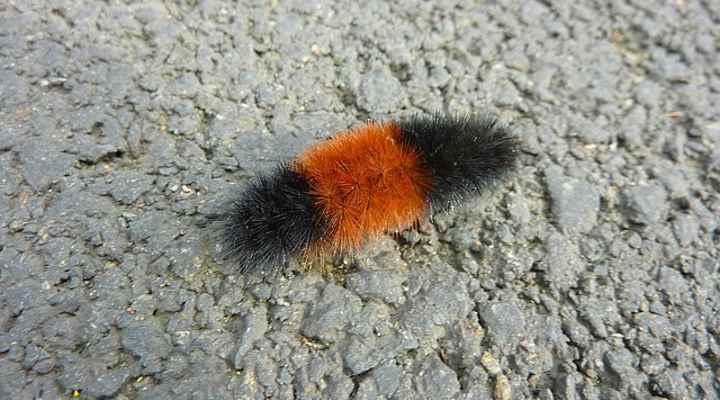
The woolly bear caterpillar is a furry caterpillar with black and orange or brown hairs
The woolly bear caterpillar is a furry caterpillar species with an orange-brown band around the center of its body and black bands at its head and tail. The black and brown caterpillar looks spiny and dangerous, but it’s not a stinging caterpillar. The fuzzy larvae measure 2.3” (60 mm) long.
Also called the banded woolly bear or black-ended bear caterpillar, the common North American caterpillar is found on milkweed, elms, asters, birch trees, and sunflowers. The fuzzy caterpillar is also common in Florida. After pupating, the brown and black caterpillar turns into an orangey-brown moth with black spots on its abdomen.
Related reading: Types of black and orange caterpillars.
Brown caterpillar identification
The woolly bear caterpillar is identified by short spiky tufts of brown and black hairs covering its body, making it easy to recognize.
- Adult Stage: Isabella tiger moth, a medium-sized moth with orange and black wings
- Caterpillar Feeds on: Various plants, including grasses, clover, low-growing vegetation, and weeds including plantain, dandelion, and nettles
- Habitat: Commonly found in a variety of open habitats, including fields, meadows, and gardens; widespread in North America
- Stinging: No, they do not have stinging hairs
Yellow Woolly Bear (Spilosoma virginica)
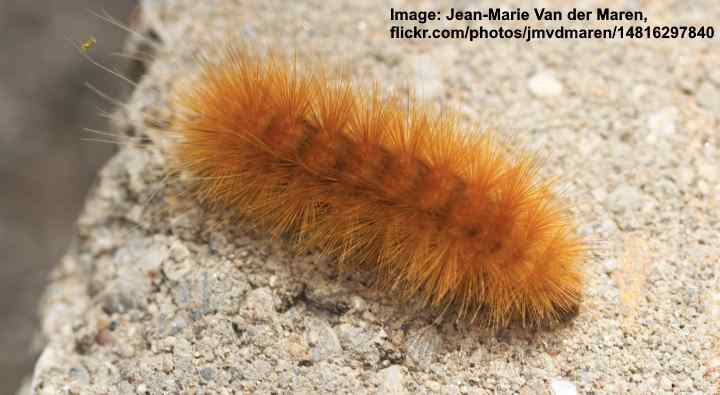
The yellow woolly bear caterpillar has irritating fuzzy hairs and it can vary in color from dark to light brown, and even yellow or orange
The yellow woolly bear is a furry brown caterpillar covered in tufts of irritating spines. This woolly bear species is usually a dark brown to creamy yellow color of the larva. The hairy tufts can be yellow; however, orange-red or even black variations are also common. Yellow woolly bear brown larvae measure 2” (50 mm) long.
Although the yellow woolly bear has long pencil-like spines, it’s not classed as a stinging caterpillar. However, the hairy tufts can cause irritation when handled. In addition, the fuzzy brown caterpillars can damage the foliage of low-growing, ground cover plants. Yellow woolly bears are active from May through November.
Brown caterpillar identification
The yellow woolly bear caterpillar is identified by its brown to tan-colored body covered in spiny tufts of yellow or orangey-red hairs.
- Adult Stage: Virginian tiger moth, a white moth with black spots
- Caterpillar Feeds on: Feeds on a variety of plants, including dandelions and other low-growing vegetation
- Habitat: Found in open areas, including gardens and fields; primarily found in North America
- Stinging: No, they do not have stinging hairs
Eastern Tiger Swallowtail (Papilio glaucus)
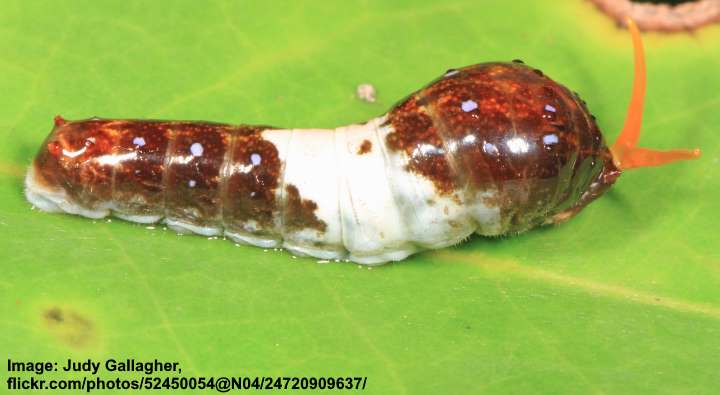
The brown and white eastern tiger swallowtail caterpillar displays an orange defensive organ (osmeteria) when it is threatened
The caterpillar of the eastern tiger swallowtail butterfly has two color forms — brown and green. During the first three growth stages (instars), the caterpillar is a chocolate brown color. It has a large white spot called a saddle around the middle of its abdomen. The brown and white caterpillar measures 2.2” (55 mm) long.
As the large plump brown caterpillar matures, it becomes a dark green caterpillar with unusual black, yellow, and blue eye markings. There are also small antennae-like spikes on the caterpillar’s tail. Before entering the pupal stage, the eastern tiger swallowtail will turn dark brown again.
Depending on the instar, pictures of the caterpillar may show it as a type of green caterpillar or brown caterpillar.
Brown caterpillar identification
The eastern tiger swallowtail caterpillar is a hairless brown caterpillar with a white band around its middle and two small false eyes.
- Adult Stage: Eastern tiger swallowtail butterfly, a large butterfly with yellow wings and black stripes
- Caterpillar Feeds on: Feeds on the leaves of trees like tulip poplar and cherry
- Habitat: Found in a variety of wooded habitats and gardens; primarily found in North America
- Stinging: No, they do not have stinging hairs
Pearl Crescent Caterpillar (Phyciodes tharos)
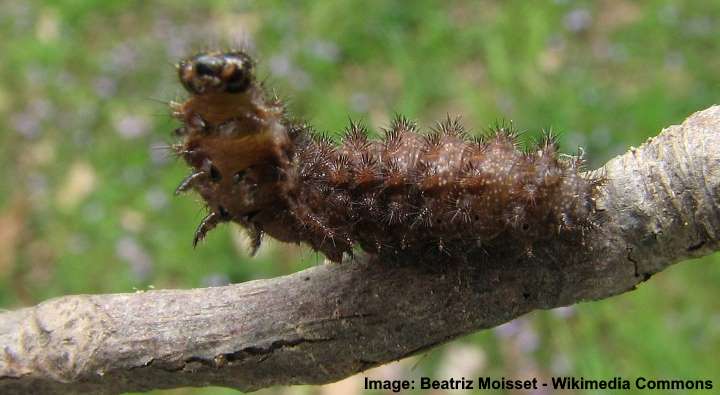
The pearl crescent caterpillar is identified by its dark brown body, tiny white dots and small spiky hairs
The caterpillar of the pearl crescent butterfly has a dark chocolate brown body with white dots, and eight rows of spiky brown hairs. The fat brown caterpillar has a small black head, and it raises its front end in a defensive position. The pearl crescent caterpillar measures 1.5” (38 mm) long.
The pearl crescent caterpillar is often found feeding on aster leaves. The spiky brown larvae can do tremendous damage by defoliating plants and skeletonizing their leaves. After pupating, the dark brown caterpillars turn into beautiful orange and black butterflies.
Brown caterpillar identification
A pearl crescent caterpillar is chocolate brown, with a white mid-dorsal line that is more visible as the caterpillar matures. They have tiny white dots and eight rows of brown spines.
- Adult Stage: Pearl crescent butterfly, a small butterfly with orange wings marked with black spots
- Caterpillar Feeds on: Feeds on aster leaves
- Habitat: Often found feeding on aster leaves; primarily found in North America
- Stinging: No, they do not have stinging hairs
Ruby Tiger Caterpillar (Phragmatobia fuliginosa)
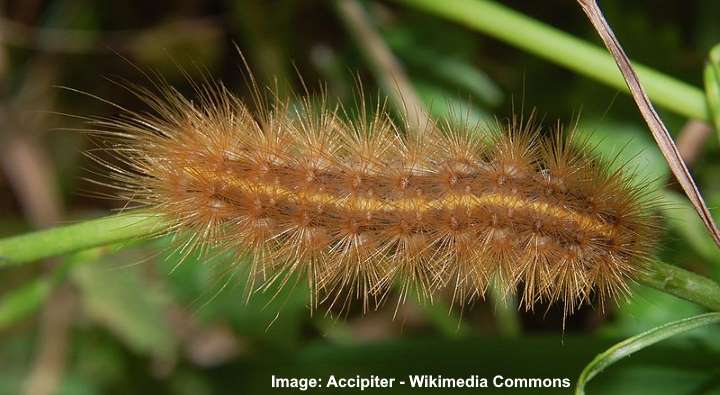
The ruby tiger caterpillar has orange-brown hairs and a yellow line along its back
The caterpillar of the ruby tiger moth is a furry orangey-brown crawling insect with a dark gray or blackish-brown head. Like many species of fuzzy caterpillars, the bug’s body is covered in tufts of stinging hairs and spines. Ruby tiger moth caterpillars measure 1.2” (30 mm) long.
Ruby tiger caterpillars are active in spring before transforming into furry orange moths. You will often find ruby tiger larvae feeding on the foliage growing on willow shrubs, cabbage, berry bushes, broadleaf plantain, and clover.
Brown caterpillar identification
A ruby tiger caterpillar is identified by its light reddish-brown covering of hairs and a yellowish band along its back.
- Adult Stage: Ruby tiger moth, a furry orange moth
- Caterpillar Feeds on: Foliage of willow shrubs, cabbage, berry bushes, broadleaf plantain, and clover
- Habitat: Found in areas where its host plants grow; primarily found in Europe, including the United Kingdom
- Stinging: No, they do not have stinging hairs
Imperial Moth Caterpillar (Eacles imperialis)
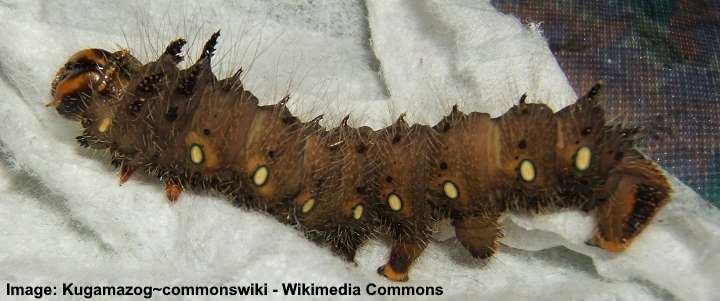
The large imperial moth caterpillar has dark brown body with spines and pale yellow spots along its sides
The caterpillar from the imperial moth is a sizable spiny larva with a dark brown and burgundy body with a row of yellow dots along its sides. Pictures show that the brown caterpillar has spikes on each segment and is covered in thin, wispy filaments. The massive brown caterpillar grows up to 5.5” (10 cm) long.
The imperial moth caterpillar goes through several instars before becoming a sizable yellow moth. The larvae emerge dark orange with black bands. They then darken in color and grow larger throughout each instar. Before pupation, they are giant dark brown or bright green caterpillars covered in spines.
Brown caterpillar identification
Brown imperial moth caterpillars are identified by a row of yellowish oval circles, fine hairs, and several fleshy spines covered in white dots.
- Adult Stage: Imperial moth, a large, yellow moth
- Caterpillar Feeds on: Various trees, including oak, hickory, maple, and pine
- Habitat: Found on the host trees where they feed; primarily found in North America
- Stinging: No, they do not have stinging hairs
Pandora Sphinx Moth (Eumorpha pandorus)
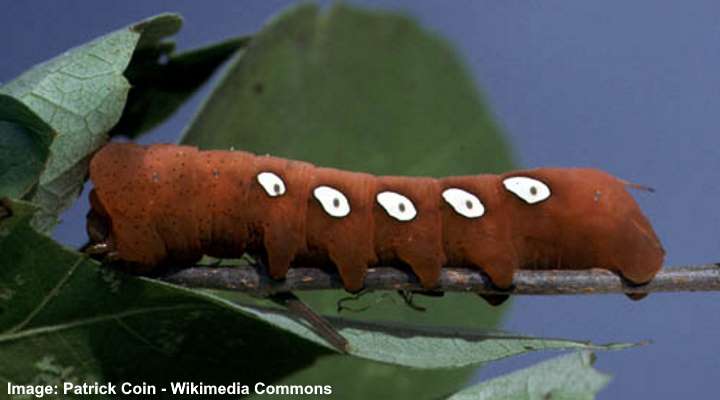
The large pandora sphinx moth caterpillar is identified by its smooth brown body and white spots on each side
The caterpillar from the pandora sphinx moth is a large, hairless brown caterpillar with large five or six white oval spots along each side. The brown, white-spotted caterpillar has a characteristic curled horn at the tail end of its abdomen. Before pupating, the large, dark cinnamon-brown caterpillars measure 3.5” (89 mm).
After pupation, the large brown caterpillar emerges as an olive green moth that looks like a leaf. The caterpillar feeds on grape foliage and Virginia creeper plants and is found through the Midwest and Eastern North America – from Nova Scotia to South Florida.
Brown caterpillar identification
The pandora sphinx moth caterpillar is identified as a large, smooth-bodied cinnamon-colored larva with black dots around its head, oval white markings, and a curly tail.
- Adult Stage: Pandora sphinx moth, an olive green moth
- Caterpillar Feeds on: Grape foliage and Virginia creeper plants
- Habitat: Found throughout the Midwest and Eastern North America, from Nova Scotia to South Florida
- Stinging: No, they do not have stinging hairs
Viceroy (Limenitis archippus)
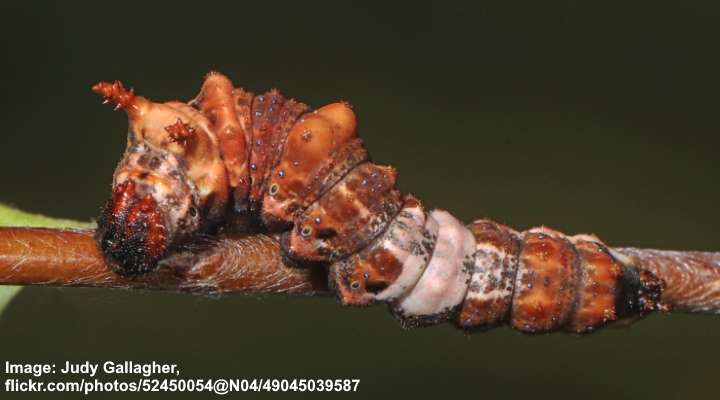
The viceroy caterpillar has brown, orange and white body with spiky horns at its head
The caterpillar from the viceroy butterfly is an ugly-looking patchy orange and brown caterpillar with a distinctive white marking on its abdomen. Its body has bumps, bristles, spiky antennae, and a patchy appearance. Due to the white abdominal patch, the brown viceroy caterpillar looks like bird droppings.
Despite its unsightly appearance, the brown and white caterpillar emerges as a stunning orange and black butterfly that resembles the monarch butterfly.
Brown caterpillar identification
The viceroy moth caterpillar has an orange-brown color with spiky horns at its head and a white and gray patch giving the appearance of bird droppings.
- Adult Stage: Viceroy butterfly, an orange and black butterfly
- Caterpillar Feeds on: Willow, poplar, and birch trees
- Habitat: Woodlands and gardens where host trees grow; primarily found in North America
- Stinging: No, they do not have stinging hairs
Striped Garden Caterpillar (Trichordestra legitima)
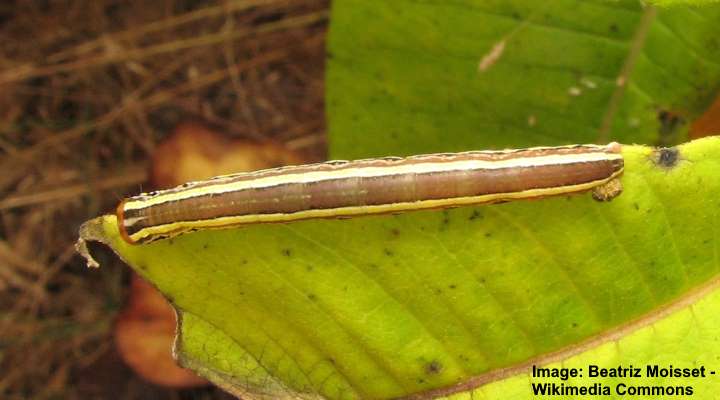
The striped garden caterpillar is identified by its dull light brown smooth body with creamy-white or yellow stripes
The striped garden caterpillar is a slender brown caterpillar with light yellowish stripes running down its body. This species of striped caterpillar has an orangy-brown rounded head and a slightly tapered tail end. Before pupation, the worm-like striped caterpillar measures around 1.4” (35 mm) long.
Brown caterpillar identification
The striped garden caterpillar is identified as a pale brown worm-like bug with bright yellow or creamy white stripes running the length of its sides.
- Adult Stage: Transforms into a moth
- Caterpillar Feeds on: Various plants, including tomatoes, cabbage, and other vegetables and crops
- Habitat: Found in gardens and agricultural fields; primarily found in North America
- Stinging: No, they do not have stinging hairs
American Painted Lady Butterfly Caterpillar (Vanessa virginiensis)
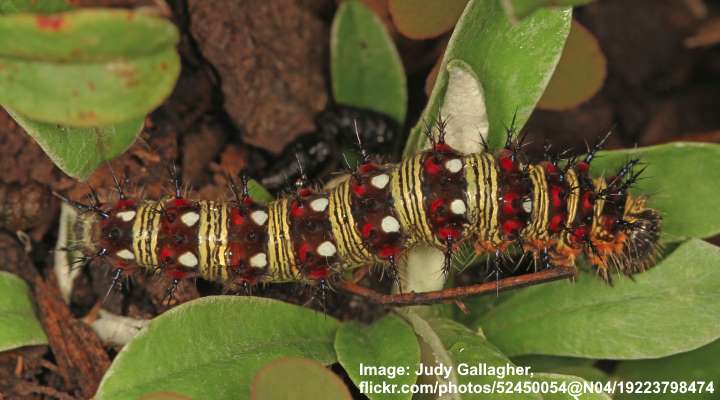
The American painted lady caterpillar has pale yellow stripes on its brown body with red and white dots
The caterpillar from the American painted lady butterfly has a dark brownish body with yellow bands, white dots, and several spiny spikes with a red base. You’ll also notice a creamy white line running the length of its body. Full-grown caterpillars measure 1.4” (35 mm) long.
The colorful spiky caterpillar often destroys the foliage on ironweed, asters, and pussytoes. As with many types of stripy, spiky caterpillars, there is variation in the colors.
Brown caterpillar identification
The American painted lady butterfly caterpillar is identified by its dark brown to black body with yellow and black rings, red and white dots, and spiny appearance.
- Adult Stage: American painted lady butterfly, a small butterfly with orange-brown wings and black spots
- Caterpillar Feeds on: Ironweed, asters, pussytoes, and other plants
- Habitat: Feeds on host plants in various habitats, including open areas and gardens; primarily found in North America
- Stinging: No, they do not have stinging hairs
Unicorn Moth Caterpillar (Schizura unicornis)
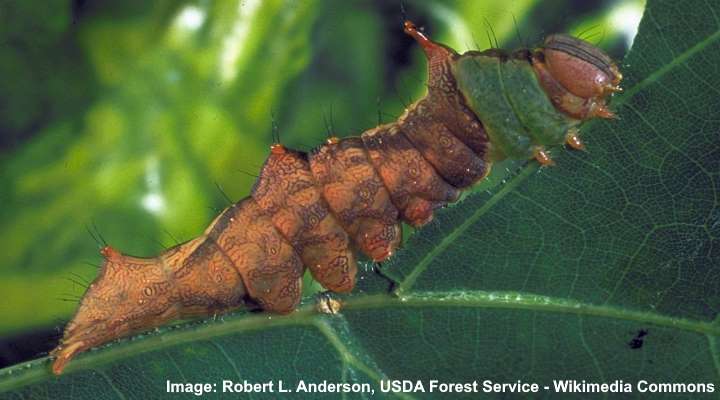
The unicorn moth caterpillar has a mottled brown body with 2 green segments near its front horn
The caterpillar from the unicorn moth is a plump brown bug with a dark brown mottled pattern on its body and two green segments near the head. This brown caterpillar’s features are its pointed triangular tail end, thin black spines, and conspicuous horn near the front. This brown larva grows up to 1.5” (38 mm) long.
You can often find the unicorn moth caterpillar on birch trees, apple trees, elm trees, and willow trees from May until October.
Brown caterpillar identification
The unicorn moth caterpillar has a mottled brown pattern, two bright green segments, and a horn-like protuberance near the rounded head.
- Adult Stage: Transforms into a moth
- Caterpillar Feeds on: Birch trees, apple trees, elm trees, and willow trees
- Habitat: Found on host trees where they feed; primarily found in North America
- Stinging: No, they do not have stinging hairs
Yellow-Striped Armyworm (Spodoptera ornithogalli)
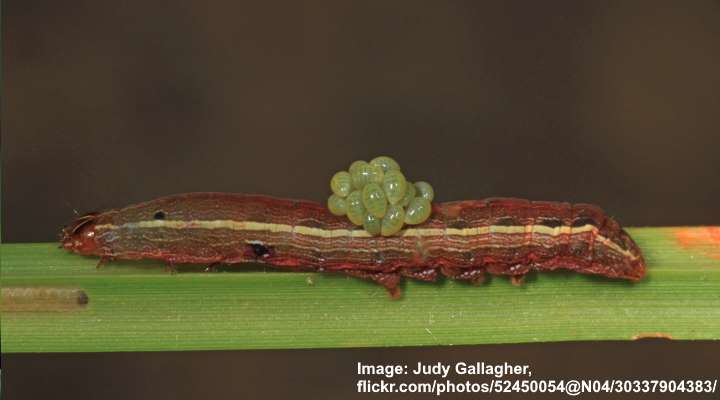
A picture of yellow-striped armyworm with wasp eggs on its brown body
Also called the cotton cutworm, the brown, yellow-striped armyworm is a sizable fat caterpillar growing up to 1.4” (35 mm) long. The worm-like caterpillar has a brown body with two recognizable yellow stripes along its back. The caterpillar is also covered in white dots with small random black patches on its body.
The gregarious caterpillars skeletonize foliage of tomato, cotton, onions, cabbage, and other vegetables and crops. After pupation, the brown caterpillar emerges as an attractive furry brown moth.
Brown caterpillar identification
The yellow-striped armyworm is identified as a brown caterpillar with a continuous yellow stripe along each side. The larva has a small, rounded head and a light-colored inverted V-shape on the face.
- Adult Stage: Transforms into a moth
- Caterpillar Feeds on: Various vegetable and crop plants, including tomato, cotton, onions, and cabbage
- Habitat: Found in agricultural fields and gardens; widespread in North America
- Stinging: No, they do not have stinging hairs
European Corn Borer (Ostrinia nubilalis)
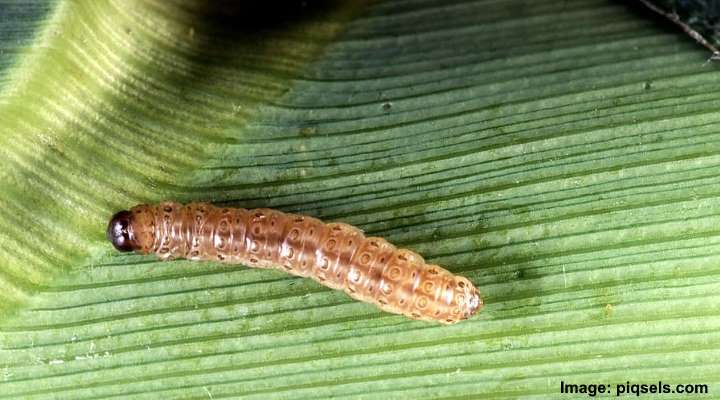
The European corn borer has a dull pale brown smooth body with small spots and dark brown-black head
The caterpillar from the European corn borer moth is a light, yellowish-brown caterpillar with small round spots on its segmented body. The small tan-colored caterpillars have a black head and lack any identifiable spines or hairs. The small, destructive larva measures between 0.08” and 0.8” (2 – 20 mm) as it matures.
As its name suggests, this plant-eating bug feeds on grain plants, mainly corn (maize). The boring caterpillar buries into plant stems and chews through various plant parts as it destroys crops.
Brown caterpillar identification
The brown European corn borer caterpillar has a beige-brown, slender body and a blackish-brown head.
- Adult Stage: Transforms into a moth
- Caterpillar Feeds on: Corn (maize) and other grain plants
- Habitat: Found in cornfields and grain crops; primarily found in North America and parts of Europe
- Stinging: No, they do not have stinging hairs
Southern Flannel Caterpillar (Megalopyge opercularis)
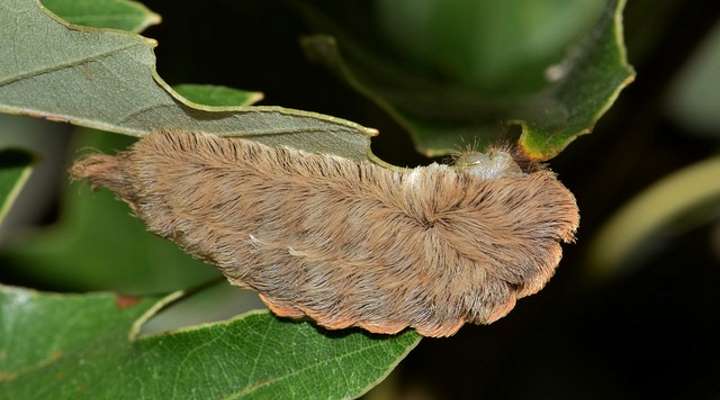
The small Southern flannel caterpillar is one of the fluffiest types of furry caterpillars with light brown hairs
The caterpillar from the southern flannel moth is a brown hairy caterpillar covered in hair-like bristles (setae). The furry caterpillar is a sandy-brown or golden-brown color, and the seemingly soft hair hides venomous spines. The small fuzzy venomous caterpillar only measures around 1” (25 mm) long.
Other names for this unusual stinging caterpillar include puss caterpillar, fire caterpillar, and woolly slug. These common names come from the caterpillar’s resemblance to a soft Persian cat — hence the name puss. Fire caterpillar gets its name from the stinging spines.
Brown caterpillar identification
The southern flannel caterpillar is a hairy caterpillar with soft golden-brown setae. The puss caterpillar has a broad, rounded head and a tapered tail end.
- Adult Stage: Transforms into a moth
- Caterpillar Feeds on: Various trees and shrubs
- Habitat: Found in wooded areas and gardens; primarily found in North America
- Stinging: Yes, they have stinging hairs that can cause skin irritation upon contact
Puss Moth (Cerura vinula)

The fat brown puss moth caterpillar has white lines and unusual forked tail
The puss moth caterpillar is a large, bloated-looking brown caterpillar with bright white lines over its abdomen. The unusual caterpillar is only chocolatey-brown during its final stage before pupation. This striking larva is identified by its forked tail and habit of raising its head and extending pinkish whiplike antennae when threatened.
Each stage of the puss moth caterpillar’s growth is different. Immature, the caterpillar is black with a long tail. Then it becomes bright green with a strange face-like marking on its head. Then it becomes dark brown before pupation.
Brown caterpillar identification
In its final stage, the puss moth caterpillar is dark brown with two identifiable white stripes along its back.
- Adult Stage: Puss moth, a large, brownish-gray moth
- Caterpillar Feeds on: Willow, poplar, and other trees
- Habitat: Found on host trees where they feed; primarily found in Europe, including the United Kingdom
- Stinging: No, they do not have stinging hairs
Pink-Spotted Hawkmoth (Agrius cingulata)

The large pink-spotted hawkmoth caterpillar has dark brown body with orange lines and creamy patterns and pointed tail
The caterpillar from the pink-spotted hawkmoth is a large, stout, horned caterpillar. The most common color of this species is a dark brown, almost black color with cream triangular shapes along its sides and two orange lines along its back. The enormous brown caterpillar can grow around 3.14” (8 cm) long.
The large caterpillar is found throughout the United States feeding on sweet potato, morning glory, and jimson weed leaves.
Brown caterpillar identification
The pink-spotted hawkmoth caterpillar has a dark brown, hairless body with identifiable triangular markings, dorsal stripes, and a pointed tail.
- Adult Stage: Pink-spotted hawkmoth, a large, brown moth with pink spots
- Caterpillar Feeds on: Sweet potato, morning glory, and jimson weed leaves
- Habitat: Found throughout the United States where host plants grow
- Stinging: No, they do not have stinging hairs
Monkey Slug Caterpillar (Phobetron pithecium)
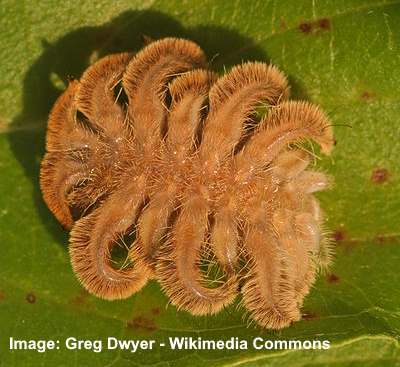
The light brown monkey slug caterpillar has an unusual shape with irritating hairs
One of the strangest-looking hairy caterpillars is the monkey slug caterpillar. This light brown-colored caterpillar looks as if it has hairy arms and resembles a squashed hairy spider.
The stinging hairs on the monkey slug caterpillars can cause skin irritation. In some people, an allergic skin reaction may happen from handling a Monkey slug caterpillar.
Brown Caterpillar Identification
It’s easy to identify a monkey slug caterpillar because there is no other insect larva like it. Its body looks like a light brown squashed hairy spider with leg-like protrusions of various sizes along its sides. The tiny brown hairy caterpillars grow up to 1” (2.5 cm).
- Adult Stage: Transforms into a moth
- Caterpillar Feeds on: Various trees and shrubs
- Habitat: Found in wooded areas and gardens; primarily found in North America
- Stinging: Yes, they have stinging hairs that can cause skin irritation upon contact
Related articles:
